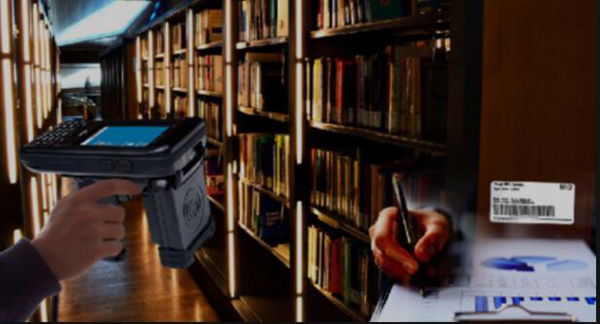
RFID is the latest technology to be used in libraries. Unlike the old fashioned EM (Electro-Mechanical) and RF (Radio Frequency) systems, which have been used in libraries for decades, RFID based systems provide more security and efficient for the tracking of materials throughout the library, including easier and faster Check-in and Check-out, inventorying, and materials handling.
Thanks to the RFID technology all material can be handled without exception. Even Videos and DVDs can be tagged and identified. The RFID technology provides an almost 100 percent detection rate. There is no false alarm once an RFID system is properly tuned.
The main advantages of using RFID technology in libraries are:
High-speed inventory including identify items which are out of proper order. RFID technology provides the possibility to scan books on the shelves without removing them just by using a proper hand-held inventory reader.
Rapid Check-in / Check-Out with fast stack reading and automatic book drops.
Theft detection hanks to the Long Range reading capabilities of the RFID equipment with extra-wide exit gates. The corridors at the building exits can be up to 1 meter wide.
Long tag life and high reliability.
Standards
Standards for RFID in libraries are essential because library materials are not only used by the owning library, but also by others via interlibrary loan. Common standards would make it possible to circulate borrowed items without entering information manually. If RFID hardware and software vendors can deliver standardized products internationally, their cost is reduced.
Finally, standards can avoid libraries being dependent upon specific vendors as is the case when vendors use proprietary protocols. When there is conformity to the relevant standards, it is possible to change vendors in case of poor performance or a business failure.
The relevant RFID standards for libraries are ISO 15693, ISO 18000-3, SIP2, NCIP, and ISO 28560.
Differentiation Among RFID Systems
While library RFID systems have a great deal in common with one another, including the use of high-frequency (13.56 MHz), passive, read-write tags, there are some significant differences:
1. An RFID system may manage security by using a “theft” bit on the tag that can be turned on or off, or it may interface with an integrated library system and query that system to determine the security status. It may even do both.
2. The RFID tags may contain only item identification numbers or they may contain considerable additional information, some of which may be permanent and some capable of being rewritten. A 74 or 95 bit tag can accommodate only item identification, a 256 bit tag can accommodate a small amount of additional information such as location, and a 1024 or 2048 bit tag can also accommodate limited bibliographic information for an item.
3. Some tags have a noticeable bump because they have been produced using “solder and bond” technology, while others have almost no bump because they use the “flip chip” technology that fuses the chip to the antenna. The latter type is less obvious.
4. Some vendors offer only proprietary tags while others offer tags that conform to a national standard supported by multiple vendors. However, almost all vendors are expected to support the new ISO 28560 standard and the parallel NISO standard that spells out the options to be used by U.S. libraries.